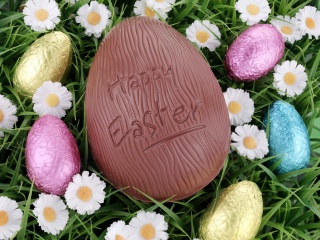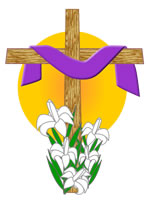|
Easter in the UK
In the UK Easter is one of the major Christian festivals of the year. It is
full of customs, folklore and traditional food. However, Easter in Britain has
its beginnings long before the arrival of Christianity. Many theologians
believe Easter itself is named after the Anglo-Saxon goddess of the dawn and
spring - Eostre.
In Britain Easter occurs at a different time each year. It is observed on
the first Sunday after the first full moon following the first day of spring in
the N
orthern Hemisphere. This means that the festival can occur on any Sunday
between March 22 and April 25. Not only is Easter the end of the winter it is
also the end of Lent, traditionally a time of fasting in the Christian
calendar. It is therefore often a time of fun and celebration.
The Friday before Easter Sunday and the Monday after are a bank holiday in
the UK. Over Easter schools in the UK close for two weeks, just enough time to
digest all the chocolate.
Maundy Thursday
Maundy Thursday is the Thursday before Easter. Christians remember it as
the day of the Last Supper, when Jesus washed the feet of his disciples and
established the ceremony known as the Eucharist. The word Maundy" comes
from the French word, "Mande," meaning "command" or
"mandate” and is taken from the command given by Christ at the Last
Supper, "love one another as I have loved you.”
In Britain, the Queen takes part in the Ceremony of the Royal Maundy, which
dates back to Edward 1. This involves the distribution of Maundy Money to
deserving senior citizens (one man and one woman for each year of the
sovereign's age), usually chosen for having done service to their community.
They receive ceremonial red and white purses which contain coins made
especially for the occasion. The white purse contains one coin for each year of
the monarch's reign. The red purse contains money in place of other gifts that
used to be given to the poor.
Good Friday
On the Friday before Easter, Christians commemorate the crucifixion of
Jesus Christ. It is a day of mourning in church and special Good Friday
services are held where Christians meditate on Jesus's suffering and death on
the cross, and what this means for their faith.
Calling it 'Good Friday' may seem a bit bizarre, but some people think that
it was once called God's Friday or Holy Friday.
Symbols of Easter
Many of the symbols and traditions of Easter are connected with renewal,
birth, good luck and fertility.
  The Cross The Cross
Of course as it is a Christian festival one of the main symbols is a cross,
often on a hill. When Jesus was crucified, the cross became a symbol of
suffering. Then with the resurrection, Christians saw it as a symbol of victory
over death. In A.D. 325, Constantine issued a decree at the Council of Nicaea,
that the Cross would be the official symbol of Christianity.
 Palms Palms
The week of Easter begins on Palm Sunday. Why Palm Sunday? Well, in
Roman times it was customary to welcome royalty by waving palm branches, a bit
like a ticker-tape parade. So, when Jesus arrived in Jerusalem on what is now
known as Palm Sunday, people welcomed him with palm branches carpeting the streets
and waving them. Today, on Palm Sunday, Christians carry palm branches in
parades, and make them into crosses and garlands to decorate the Church.
 Easter Eggs Easter Eggs
Easter eggs are a very old tradition going to a time before Christianity.
Eggs after all are a symbol of spring and new life.
Exchanging and eating Easter eggs is a popular custom in many countries. In
the UK before they were replaced by chocolate Easter eggs real eggs were used,
in most cases, chicken eggs. The eggs were hard-boiled and dyed in various
colors and patterns. The traditionally bright colours represented spring and
light. Sadly, nowadays if you gave a child in Britain a hard-boiled egg on Easter
Sunday, you would probably end up wearing it!
An older more traditional game is one in which real eggs are rolled against
one another or down a hill. The owner of the egg that stayed uncracked the
longest won. Even today in the north of England, for example as at Preston in
Lancashire, they still carry out the custom of egg rolling. Hard boiled eggs
are rolled down slopes to see whose egg goes furthest. In other places another
game is played. You hold an egg in the palm of the hand and bang against your
opponent's egg. The loser is the one whose egg breaks first.
Nowadays people give each other Easter eggs made of chocolate, usually
hollow and filled with sweets. On TV you will see adverts for Cadbury's Creme
Eggs, a very sweet confectionery. The catchphrase for the adverts is "How
do you eat yours?" And Britain children hunt for (chocolate) Easter eggs
hidden about the home or garden by the Easter bunny.
 The Easter Bunny The Easter Bunny
Rabbits, due to their fecund nature, have always been a symbol of
fertility.The Easter bunny (rabbit) however may actually be an Easter hare. The
hare was allegedly a companion of the ancient Moon goddess and of Eostre.
Strangely the bunny as an Easter symbol seems to have it's origins in
Germany, where it was first mentioned in German writings in the 16th Century.
The first edible Easter bunnies appeared in Germany during the early 1800s,
they were made of pastry and sugar.
In the UK children believe that if they are good the "Easter Bunny
" will leave (chocolate) eggs for them.
Sadly hare hunting (hare coursing) used to be a common pastime at Easter.
But this might please some of the more fundamentalist Christians, who consider
the fluffy fellow to be unchristian.
Morris Dancing
 Morris dancing is a traditional English form of folk dance which is also
performed in other English-speaking countries such as the USA and Australia.
The roots of morris dancing seem to be very old, probably dating back to the
Middle Ages. Morris dancing is a traditional English form of folk dance which is also
performed in other English-speaking countries such as the USA and Australia.
The roots of morris dancing seem to be very old, probably dating back to the
Middle Ages.
In the dance men dress up in costumes with hats and ribbons and bells
around their ankles. They dance through the streets and one man often carries
an inflated pigs bladder on the end of a stick. He will run up to young women
in the street and hit them over the head with the pigs bladder, this is
supposed to be lucky (men)!
Dressing Up For Easter
Easter was once a traditional day for getting married, that may be why
people often dress up for Easter. Women would make and wear special Easter
bonnets - decorated with flowers and ribbons. Even today in Battersea in London
there is a special Easter Parade, where hand-made bonnets are shown off.
Hot Cross Buns
Hot cross buns, now eaten throughout the Easter season, were first baked in
England to be served on Good
Friday. These small, lightly sweet yeast buns contain raisins or currants and
sometimes chopped candied fruit. Before baking, a cross is slashed in the top
of the bun. After baking, a confectioners' sugar icing is used to fill the
cross.
An old rhyme was often sung by children awaiting their sugary treat:
"Hot cross buns, 
hot cross buns,
one a penny, two a penny,
hot cross buns.
If you do not like them,
give them to your sons,
one a penny, two a penny,
hot cross buns."
|